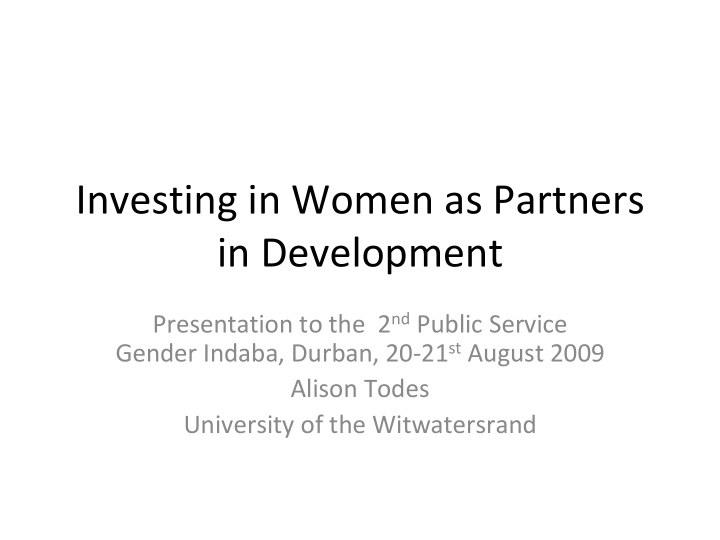



Investing in Women as Partners in Development Presentation to the 2 nd Public Service Gender Indaba, Durban, 20 ‐ 21 st August 2009 Alison Todes University of the Witwatersrand
Introduction • Talk focuses on local government • On what decentralisation and integrated development planning have meant for women’s rights defined at national level • Reflects a study undertaken with Dr. Pearl Sithole (HSRC) and Amanda Williamson (Wits)
Introduction • International pressure for decentralisation to local government • Assumes its good for women as local government is closer and more accessible • But questions raised: – Local politics can be more conservative – Easier for women to organise at national level – Capacity/resources at local level may be too limited • So research is looking at what happens to women’s rights defined at national level in the context of decentralisation
Background • Decentralization in SA takes form of ‘decentralized centralism’ – increased powers and functions in autonomous and democratically elected local government – along with a strong centre in terms of policy and guidelines, finances, and political processes. • Reflects political history
Background After 1994, fragmented and racially based local government was • consolidated into large units. Two ‐ tier system of district and local government outside of metropolitan • areas (unitary local government ) local government is now ‘developmental’: promoting social and economic • development, as well as democratic, participatory governance Local Integrated Development Plans (IDPs) introduced as strategic plans • for municipalities IDPs also to give direction to local work of other spheres of government • But elements of centralization: • – Local government and IDPs expected to carry through constitutional principles and national policies – Political processes are centralized – Small local government budgets (15% of expenditure) and dependence on conditional national grants – outside of big cities Decentralisation is uneven: varying resources and capacities •
Background and Context • SA’s Constitution commits to gender equality • Commitments carried through in several policies (albeit uneven) • National Gender Policy Framework and national gender machinery • Reflects strength of women’s movement (national) in early 1990s and its impact on policy making processes • But this organisation has subsequently declined
Key Questions • What happens to women’s rights and entitlements defined at national level in the context of decentralization to local government, and particularly through IDPs as a decentralised planning process? • Sub ‐ questions: – To what extent have gender equity and women’s rights been seen as key principles informing the design of the IDP process at the national level? – Do local participatory processes give women voice in the IDP? – Do municipal planning and budgeting processes reflect women’s interests, needs and rights? – Do projects and implementation processes take into account women’s needs and rights?
Key Findings • Local government has been a sphere in which the objectives of gender equity have been slow to take hold. • Women’s organisations have largely focused on the national level • Gender machinery mainly national and provincial level – only starting to be developed at local level, and only some places • Some support for mainstreaming gender in IDPs (documents), but not carried through in practice • Partly reflects crisis of local government • Where gender is taken up, focus has mainly been on representation of women
Key Findings In the first local government elections (1995) only 19% of • representatives were women, in contrast to 27.7% at national level. But has increased to 28.2% in 2000, and 39.7% in 2006. • But women depend on political parties to get elected, and thus are • beholden to party interests. Local government representatives are divided between • Proportional Representation (PR) and ward seats. Women are more strongly represented in PR seats controlled by • political parties, yet ward councillors are seen as closer to communities, and as more representative Better representation and more inclusive politics in metropolitans • areas than in more conservative rural areas , where traditional leadership and political practices prevail
Key Findings • Research conducted on 3 municipalities 2004 ‐ 6, but most before recent rise in women’s representation • Limited political pressure on local government to attend to gender: absence of local organisations focused on gender, and CBOs not coming together around these issues • Local gender structures only in stronger municipalities, and still new • Women were very present in the IDP participatory processes, but real voice/impact shaped by local politics • Even where women were vocal, the IDPs themselves are largely silent on gender. • Still, IDPs focus on basic services of importance to women
Key Findings • But women benefiting at a project level in several areas of infrastructure development and local economy – across municipalities. • Women are involved in committees, as workers, and as beneficiaries. • Partly consequence of national guidelines which insist on the inclusion of women. • But women continue to remain in marginal positions in development projects • Variations among municipalities – greater transformation in bigger cities – more open politics, better resources and capacities
Implications • Need both ‘top ‐ down’ and ‘bottom ‐ up’ approaches • Importance of national frameworks, guidelines and quotas for ensuring women’s inclusion at local level – even though these have limits • In SA, where decentralization involves inter ‐ governmental co ‐ ordination through IDP processes – are spaces to promote inclusion of women and gender • Importance of increasing women’s representation and participation • Importance of promoting women’s organisation, and drawing stronger links to local government
Implications • Value of gender analysis within IDPs/municipal planning – helps to understand the range of men and women’s needs in municipality • Build on ‘good practices’ in projects • Value of approaches that move beyond numbers of women to empowerment: Skills transfer Capacity building Mentoring Multi ‐ dimensional support
Recommend
More recommend